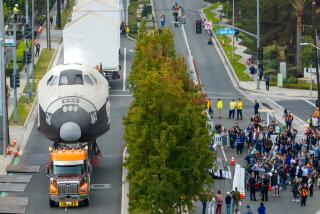The fate of a wing shaped by politics
- Share via
Fragments of Columbia were laid out on a vast concrete floor like broken bones on an autopsy table.
Seared shards, wet with pine needles and caked with mud, were barely recognizable as fuselage, wings, tail and flaps.
Once-sleek contours were crusted with charcoal-colored stove canker. Wing parts had been honed to a razor’s edge by superheated gases.
For weeks, wreckage poured into the isolated hangar at Florida’s Kennedy Space Center — 27 tractor-trailer loads in all delivered by Lone Star Trucking. The 50,000-square-foot hangar sat on a dry hillock in the tidal marsh near the space shuttle landing strip, edged by cattails and pepper trees.
Two shifts a day, six days a week, 150 NASA technicians in white suits, goggles and safety gloves laid out the remains.
They sorted pieces by thickness and arranged parts by serial number when one could be found. Otherwise, they relied on rivet patterns, burn marks, soot streaks and fracture lines — anything that would allow them to match one part with the next.
The wreckage had a story to tell, but at first it could barely be heard amid the clamor of so public an inquest.
When the independent Columbia Accident Investigation Board arrived at the hangar, NASA had already arranged the wreckage to suit itself and launched its own forensic analysis.
The rivalry was immediate.
Distrustful of board investigators, NASA technicians withheld information. They were suspicious of the investigators, who seemed too anxious to publicize discoveries before they had been fully analyzed and too eager to experiment with exotic, expensive techniques.
For their part, board members argued that openness was crucial to maintaining public faith in the investigation. Findings were to be disclosed as quickly as possible.
NASA had the manpower and the engineering resources. It controlled access to the site.
But the Columbia board — led by an uncompromising retired admiral, Hal Gehman — had impounded the wreckage. No one could test it without obtaining the board’s permission.
The board was impatient at NASA’s overly methodical approach and its resistance to new ideas, said Gregory Kovacs, a Stanford University biomedical engineer who supervised debris analysis for the board.
Suspicions about possible damage to the left wing were so strong, Kovacs said, that it seemed more sensible to devote extra effort to studying its fragments, rather than slowly analyzing all of the debris.
On occasion, board investigators and NASA experts found themselves in shouting matches over the best way to proceed.
It was implicitly an argument over how history would judge what happened.
Slowly, the work moved forward.
Technicians examined 83,900 pieces of the shuttle. They eventually identified almost 44,000 of them.
“It was the only physical evidence we had,” Kovacs said. “It was the only ground truth.”
*
A key to interpreting the debris in the hangar was Columbia’s flight data recorder.
The battered recorder had been found in the East Texas pines by a contract firefighter named Chauncy Birdtail. It was flown to a Minnesota lab for analysis.
The tape was tangled and pinched. The force of the breakup had jammed the tape reels together. Solder on the circuit boards had melted. A large wooden splinter speared the circuits.
It had been more than 30 years since anyone at the lab had routinely worked on 1-inch tape.
Technicians stretched out the 9,200 feet of tape on a table 30 feet at a time. They washed it in deionized water, analyzed its 28 recording tracks and then gingerly rewound it by hand.
Board investigator Bruce Darling, 45, and his colleagues then read the second-by-second testimony of Columbia’s short circuits and burning wires.
They found that 620 sensors had actually recorded reliable data. Fortuitously, there were more working sensors on the left wing than anywhere else on the vehicle.
They matched the timing of interruptions in the sensor readings with the physical locations of wires that fed data to the recorder. By reconstructing the sequence of burning wires, they could follow the heat through the left wing.
The new data established the timing of the accident and, by inference, narrowed the location of the initial wing damage.
Wing sensor V07P8074A — one of the first to fail during reentry — also had recorded an unusual spike in pressure 16 days earlier, only 81.9 seconds after liftoff, just about the moment a spinning block of foam hit the leading edge.
*
Finally the debris, too, pointed to the left wing.
Searchers found 827 pieces of the wing.
Looking for the sense in so much slag, technicians in the reconstruction hangar used a computer database to match fragments against the locations where they were found.
The resulting map revealed that the left wing had disintegrated first, falling to Earth west of Nacogdoches in East Texas.
Metallurgists supervised by board investigator Mark Tanner peeled back layers of slag that coated pieces of the wing to determine which parts of the craft’s internal frame melted first.
The most thickly coated pieces of debris all came from the left wing.
The investigators also scraped away brown scum from heat-damaged tiles and discovered more quantities of iron and nickel, left no doubt by the melting spar fittings that held insulating panels in place.
With an X-ray scanner, investigators detected tiny globs of metallic spittle embedded in the left side of the fuselage. Under analysis, the spheres turned out to be sprays of shrapnel from vaporized debris.
By tracing the shrapnel’s path, they could pinpoint its source: the damaged wing. No such traces of molten metal were found on the fuselage’s right side.
In half a dozen ways, the technical evidence converged on the leading edge of the left wing, covered by a series of reinforced carbon-carbon panels, seals and fittings. There were 22 of these U-shaped panels along each wing.
After heated arguments about the $130,000 cost, NASA technicians mounted the fragments of the left wing’s leading edge on a Lucite frame, like paleontologists reconstructing the skeleton of a dinosaur.
The left wing apparently had been breached along the sharp bend of the delta-shaped span where it angled away from the fuselage. The pattern of heat damage pointed to wing panels No. 8 and 9, the largest and most complex of the wing’s protective leading-edge fittings.
The pattern of circumstantial evidence suggested that the left wing eventually broke off at that midpoint — a spot where the highest heat of reentry converged with two brutal shock waves generated by aerodynamic forces.
The shock waves, the heat and the falling debris at launch all appeared to center on the same spot along wing panel No. 8.
*
Few remember why the shuttle had a delta wing in the first place, but Max Faget does.
At his Houston home, Faget, 82, sat at his kitchen table with a small poodle named Cleo asleep in his lap — a shy, wizened man with sky-blue eyes, a narrow chin, a broad, furrowed forehead and ears like lapels.
He nursed a glass of white wine and replayed the story of the shuttle’s design the way a man who has outlived his wife, his work and his fame will relish the memory of younger, more energetic days.
Like the manned spaceflight program he helped found, Faget had an intuitive flair for engineering and an unshakable self-confidence.
A former college gymnast, he was known to perform handstands on the conference table without missing a beat in his technical presentations.
As a leading architect of human spaceflight, Faget left his stamp on virtually every U.S. manned spacecraft.
He led the team that designed the blunt-bodied Mercury and Gemini space capsules. He collaborated on the design of the Apollo moon capsule.
His name is on patent documents for the space shuttle system.
By 1969, NASA had 13 different concepts for a fully reusable shuttle on its drawing boards. Faget was the chief engineer at NASA’s Manned Spacecraft Center.
For a space shuttle, Faget had in mind a two-stage reusable rocket plane with enough cargo capacity to resupply a space station.
His design featured short, straight wings like those of a DC-3 cargo plane and a true tail so the shuttle could maneuver under its own power like an airplane, instead of gliding heavily to the ground like Columbia.
In those plans, Faget proposed that the shuttle minimize the fierce heat of reentry by descending with its nose pointed up at a much steeper angle than the spacecraft that NASA would eventually build.
The craft’s belly would act like the blunt body of the Mercury and Apollo capsules he designed, spreading the heat more evenly across the broad underside of the spacecraft, rather than concentrating it along the leading edges of the wings.
In 1971, the purity of the shuttle’s design collided with the reality of politics.
President Richard M. Nixon informed the space agency that there would be no Mars missions, no space station, no nuclear rocket engines. The remaining moon missions were canceled not long after.
Unless NASA officials could win the support of the Air Force, there would be no space shuttle either.
That meant NASA had to make more room in the cargo bay for big spy satellites. It meant NASA had to build a broad delta wing for the craft to carry out maneuvers required for military missions. All that extra weight meant an even heavier heat-shield system. Among other things, the extra pounds made it harder to accommodate the weight of crew escape pods or a stronger, more heat-resistant crew compartment.
“The delta wing was really the price of the space shuttle,” Faget said.
So enthusiastic was the Air Force about projecting its power into space that it spent $3.3 billion to build a shuttle launch facility at Vandenberg Air Force Base north of Los Angeles, as well as a classified mission control complex in Colorado.
No shuttle was ever launched from the facility.
In 1986, when the Challenger disaster grounded the entire shuttle fleet, the Air Force quickly canceled its manned spaceflight project.
Workers dismantling the discarded launch site by the sea called it “Abandon-berg.”
Faget apologized for being slow to remember details. He had reached a time in his life when the right words no longer came so readily.
“I can see them, but I can’t speak them,” he said.
Like the space agency he once served, he had slowed and his memory was fading.
*
At NASA, the men and women who tended the space shuttles were no longer its inventors and innovators. They were by necessity curators of an operational museum piece.
At least a quarter of NASA’s scientists and engineers were expected to retire within five years. Already the people over 60 outnumbered those under 30 by nearly 3 to 1.
“People talk about the learning curve,” said physicist Paul Dimotakis of Caltech. “Nobody talks about the forgetting curve.”
When it came to Columbia, time had made a mockery of NASA’s institutional memory.
The space agency had millions of technical documents meant to capture the expertise of the thousands of engineers who had designed and built the space shuttle fleet.
Over the years, there had been so many design changes and so little money to document them that thousands of shuttle blueprints appeared to describe a vehicle that no longer existed.
When accident investigators sought out a report documenting details of the shuttle’s design or performance, they often found only PowerPoint presentations.
Without the knowledgeable voice of the engineers who had originally presented them, the slides were meaningless.
The board’s investigators soon coined a phrase for this new institutional amnesia.
“Death by PowerPoint.”
More to Read
Sign up for Essential California
The most important California stories and recommendations in your inbox every morning.
You may occasionally receive promotional content from the Los Angeles Times.










